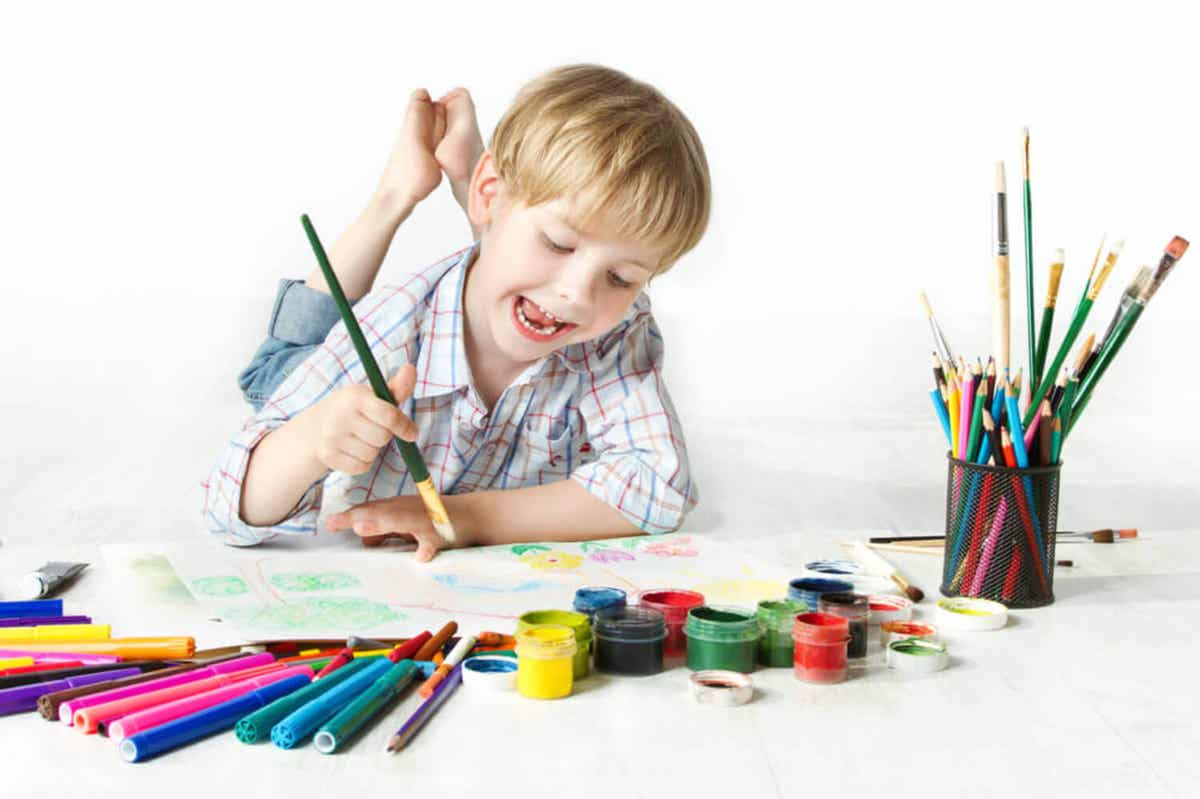Know Your Child's Personality Through The Tree Test


Written and verified by the psychologist Mara Amor López
With the tree test, you can find out what your child’s personality’s like. Children express their emotions and feelings better through drawings than through words. When you give them paper and colors, they tend to put everything that comes to mind on paper.
Often, psychologists use this type of test to know or evaluate if the child may have a problem. They’re called “projective tests”, with which we evaluate the personality. These can be used with both children and adults. Do you want to know what this tree test consists of and how it can be interpreted? Read on!
The tree test to help us get to know our children
It’s clear that a drawing isn’t going to tell us everything there is to know about our kids, but it can give us information about some personality traits that we already know, or not, and also if they’re going through a difficult time emotionally.
This technique is simple to apply and widely used in psychology consultations, both for children and adults. Do you want to know how this technique works?

The tree test: What does it consist of?
Surely there are things about your innermost self that you don’t know because, sometimes, even we’re not able to know ourselves completely. This technique is very simple to perform, quick to do, and can provide information about the subconscious. How can we put it into practice?
- The first thing we have to do is to prepare a blank sheet of paper, a pencil, and some colored pencils (colors are important).
- Once we’ve prepared the material, we ask the child (ideally between 5 and 6 years old) to draw a tree; Don’t give them any more information, only that they make this drawing. If they ask how you want it, you tell him however they want. We shouldn’t give them any further instructions.
- Now, let them spend as much time as they need; some are faster and others slower, some have more details and others fewer. Either way, we shouldn’t rush them.
How can we interpret our child’s tree test?
Once they’re completely finished with the drawing, now it’s time to analyze it; this can give us a lot of information about our child.
The ground
The ground in these projective techniques represents the child’s contact with reality. If it’s not present, it can indicate that the child feels insecure. In spite of this, it’s important to know that children under 9 years of age usually don’t draw the ground, and this doesn’t mean that there’s a problem.
- When they draw the ground, it indicates that they’re a confident, self-assured child.
- If they draw the floor on straight lines, it indicates that they’re a child with clear ideas and are very stable emotionally.
- If the ground’s wavy, it may indicate a high sensitivity and that they always try to avoid confrontations.
- When the tree appears on a mountain, it could be telling us that they’re a child who likes to be at the center of attention.
The roots
The roots come to reflect the affections of the child, as roots are the sustenance of the tree and what helps them to sustain themselves. These roots represent the “id”, which is the most hidden part of all of us.
- If the child leaves the roots out of the drawing, it may indicate that they feel weak or fear the world.
- If the child draws them, it could indicate that there’s a good emotional development, the child feels loved and accepted.
- Does the child draw the tree with many roots? This could be an indication that they have a positive and secure attachment.
- We must keep in mind that many children under 9 years of age don’t draw roots, and this doesn’t mean that they have a problem.
The trunk
The trunk’s associated with personal identity and is one of the most important elements of the tree.
- If the trunk is thin, with irregular strokes, it may indicate that the child is fearful and suggestible.
- Does the tree have holes? This could indicate an emotional emptiness.
- If the trunk is thick, with firm lines, it tells us that the child has a strong personality and character, with good self-control and discipline.
- Likewise, if the trunk’s too wide, it may indicate a tendency toward aggressiveness, narcissistic traits, and stubbornness.

The crown and branches
The crown and the branches are the upper parts of the tree, the ones that are most visible and. Therefore, they represent the child’s relationship with the outside, other people, family, friends, and also their aspirations. As before, when children are younger, they may not draw the branches, because they don’t have that level of detail when drawing.
- Branches oriented upwards could indicate an optimistic child and, if they’re drawn downward, this may indicate a tendency towards pessimism.
- If the crown and branches are made with great precision and detail, it tells us that they’re a perfectionist and a creative person.
- If the child draws a large crown, it could indicate that they’re an extroverted child. At the same time, if it’s very small in relation to the trunk, it could indicate that the child’s more introverted.
- If the little one adds fruit to the tree, it usually suggests that they have a generous and sociable personality.
Final clarifications regarding the tree test
This article on the tree test is informative for parents to help them discover or suspect some emotional problems that their child may have, but it doesn’t offer any diagnosis or validity unless it’s a professional who uses it along with other tools to assess the whole child and thus detect if there’s really a problem.
It should always be a specialist who evaluates the child as a whole, if necessary. For parents, this test is simply for orientation and to learn about aspects of the child’s personality that they may not be aware of.
With the tree test, you can find out what your child’s personality’s like. Children express their emotions and feelings better through drawings than through words. When you give them paper and colors, they tend to put everything that comes to mind on paper.
Often, psychologists use this type of test to know or evaluate if the child may have a problem. They’re called “projective tests”, with which we evaluate the personality. These can be used with both children and adults. Do you want to know what this tree test consists of and how it can be interpreted? Read on!
The tree test to help us get to know our children
It’s clear that a drawing isn’t going to tell us everything there is to know about our kids, but it can give us information about some personality traits that we already know, or not, and also if they’re going through a difficult time emotionally.
This technique is simple to apply and widely used in psychology consultations, both for children and adults. Do you want to know how this technique works?

The tree test: What does it consist of?
Surely there are things about your innermost self that you don’t know because, sometimes, even we’re not able to know ourselves completely. This technique is very simple to perform, quick to do, and can provide information about the subconscious. How can we put it into practice?
- The first thing we have to do is to prepare a blank sheet of paper, a pencil, and some colored pencils (colors are important).
- Once we’ve prepared the material, we ask the child (ideally between 5 and 6 years old) to draw a tree; Don’t give them any more information, only that they make this drawing. If they ask how you want it, you tell him however they want. We shouldn’t give them any further instructions.
- Now, let them spend as much time as they need; some are faster and others slower, some have more details and others fewer. Either way, we shouldn’t rush them.
How can we interpret our child’s tree test?
Once they’re completely finished with the drawing, now it’s time to analyze it; this can give us a lot of information about our child.
The ground
The ground in these projective techniques represents the child’s contact with reality. If it’s not present, it can indicate that the child feels insecure. In spite of this, it’s important to know that children under 9 years of age usually don’t draw the ground, and this doesn’t mean that there’s a problem.
- When they draw the ground, it indicates that they’re a confident, self-assured child.
- If they draw the floor on straight lines, it indicates that they’re a child with clear ideas and are very stable emotionally.
- If the ground’s wavy, it may indicate a high sensitivity and that they always try to avoid confrontations.
- When the tree appears on a mountain, it could be telling us that they’re a child who likes to be at the center of attention.
The roots
The roots come to reflect the affections of the child, as roots are the sustenance of the tree and what helps them to sustain themselves. These roots represent the “id”, which is the most hidden part of all of us.
- If the child leaves the roots out of the drawing, it may indicate that they feel weak or fear the world.
- If the child draws them, it could indicate that there’s a good emotional development, the child feels loved and accepted.
- Does the child draw the tree with many roots? This could be an indication that they have a positive and secure attachment.
- We must keep in mind that many children under 9 years of age don’t draw roots, and this doesn’t mean that they have a problem.
The trunk
The trunk’s associated with personal identity and is one of the most important elements of the tree.
- If the trunk is thin, with irregular strokes, it may indicate that the child is fearful and suggestible.
- Does the tree have holes? This could indicate an emotional emptiness.
- If the trunk is thick, with firm lines, it tells us that the child has a strong personality and character, with good self-control and discipline.
- Likewise, if the trunk’s too wide, it may indicate a tendency toward aggressiveness, narcissistic traits, and stubbornness.

The crown and branches
The crown and the branches are the upper parts of the tree, the ones that are most visible and. Therefore, they represent the child’s relationship with the outside, other people, family, friends, and also their aspirations. As before, when children are younger, they may not draw the branches, because they don’t have that level of detail when drawing.
- Branches oriented upwards could indicate an optimistic child and, if they’re drawn downward, this may indicate a tendency towards pessimism.
- If the crown and branches are made with great precision and detail, it tells us that they’re a perfectionist and a creative person.
- If the child draws a large crown, it could indicate that they’re an extroverted child. At the same time, if it’s very small in relation to the trunk, it could indicate that the child’s more introverted.
- If the little one adds fruit to the tree, it usually suggests that they have a generous and sociable personality.
Final clarifications regarding the tree test
This article on the tree test is informative for parents to help them discover or suspect some emotional problems that their child may have, but it doesn’t offer any diagnosis or validity unless it’s a professional who uses it along with other tools to assess the whole child and thus detect if there’s really a problem.
It should always be a specialist who evaluates the child as a whole, if necessary. For parents, this test is simply for orientation and to learn about aspects of the child’s personality that they may not be aware of.
All cited sources were thoroughly reviewed by our team to ensure their quality, reliability, currency, and validity. The bibliography of this article was considered reliable and of academic or scientific accuracy.
- Cid Rodriguez, J.M., & Castellano Arroyo, M.. (2002). El test del Árbol, su aplicación en la exploración de la personalidad en la clínica médico-forense. Cuadernos de Medicina Forense, (30), 05-21. Recuperado en 23 de julio de 2020
This text is provided for informational purposes only and does not replace consultation with a professional. If in doubt, consult your specialist.








